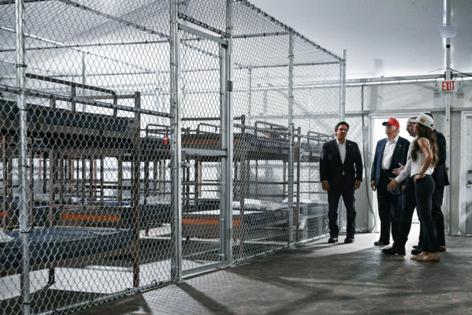At Alligator Alcatraz, contrasting immigration visions clash as Everglades facility opens
Published in News & Features
MIAMI — During an hourslong visit on Tuesday, President Donald Trump and top state and federal officials celebrated the opening of the new Florida-run immigration detention center in the Everglades as a major milestone in a joint mass deportation campaign.
Trump depicted the new facility as a harsh solution to deter undocumented immigrants from coming into the United States, and said it will soon house “some of the most vicious people on the planet.” Homeland Security Secretary Kristi Noem urged undocumented immigrants to self-deport to avoid being jailed there. And Gov. Ron DeSantis said the state-run facility should serve as a model on immigration enforcement for other states.
Outside the facility’s gates, about 50 protesters gathered, chanting “Donald Trump has got to go” and waving signs that said “communities not cages.” Trump supporters — including former Proud Boys leader Enrique Tarrio – were there, too. One supporter wielded a large sign with “We LOVE ‘DADDY’ TRUMP” scribbled in bold red letters.
The opening-day clash of opinions between elected officials inaugurating the facility and those who stood outside to oppose it revealed a larger debate over immigration enforcement in Florida and across the United States. While Trump declared during his Tuesday visit that the site would help the U.S. face a “country-destroying invasion,” recent polls show that most Americans believe Trump’s immigration enforcement has gone too far and support a legal pathway for most undocumented immigrants.
In Florida, the detention facility — whose official name is Alligator Alcatraz — is showing just how far state officials can go to be a “force multiplier” for the president’s efforts, even when the decision is a major undertaking dividing Floridians and Americans across the country.
“Don’t let Florida be the only state,” DeSantis said while standing next to Trump. “I think this is a model, but we need other states to step up.”
Alligator Alcatraz also shows how quickly the state is willing to move on immigration enforcement. Using emergency powers, the state was able to seize county land to build the facility in just eight days. It leveraged existing agreements with state contractors to build towering tents with bunk beds in chain-link cells. Officials have said the facility will be able to hold as many as 3,000 people.
The governor said detainees could be held there as early as Wednesday, but that the site will need to be swept multiple times Tuesday night to be considered “secure” before it’s able to accept anyone.
Still, DeSantis made clear that Florida does not plan to stop with Alligator Alcatraz, telling reporters that he plans to build a second detention center in Camp Blanding, a military base near Jacksonville, to house another 2,000 detained immigrants.
“You can’t have a country if you don’t have respect for the rule of the law. You can’t have a country if foreigners decide who comes in,” the governor said.
During a roundtable discussion at the facility, state and federal officials mused about the origins of Alligator Alcatraz, the first of its kind facility in the United States. Noem said that Jimmy Percival, general counsel for the Department of Homeland Security, had approached DeSantis and his administration about partnering up on a detention site.
Trump credited Florida Attorney General James Uthmeier with picking the location deep in the Everglades.
“You’re taking a little heat from some environmental groups. But I take it all the time. It’s an honor,” said Trump. “Great job, James.”
Uthmeier responded that he had been inspired by Trump’s idea of using the now-defunct Alcatraz island in San Francisco Bay, a notorious former federal prison that once held infamous gangsters, to house immigrants.
“We’ve got our own natural Alcatraz in the middle of the Everglades. Great runway, great perimeter,” he told the President. “In Florida we walk the walk.”
The detention center in the Everglades is envisioned as a “one-stop” shop for the Trump administration’s needs for detention and deportation, DeSantis said Tuesday.
With a major runway so close to the detention center, DeSantis has said that the federal government should, in theory, be able to launch deportation flights from there.
“You drive them 2,000 feet to the runway and then they’re gone,” said DeSantis.
Trump also said he would approve Florida’s plan to expedite deportations by having qualified National Guard members work as immigration judges. According to the state’s plan, proposed earlier this year as part of a larger immigration enforcement strategy, there are nine Judge Advocate General officers in the National Guard who could be trained as immigration officers, and training would take six weeks.
“He didn’t even have to ask me. He has my approval,” Trump said.
Critics gather
From near and far, critics gathered to protest
As Trump and other officials toured the facility Tuesday, dozens of protesters gathered outside. Among those present were Miccosukee Tribe members who have raised concerns about the environmental risks the facility could pose and denounced that local communities had not been consulted ahead of the facility’s construction.
Heather Cypress, a 47-year-old Miccossukee woman, became emotional as she recalled a swimming hole near the site’s entrance where she and her friends would hang out as children. It was closed down when the Collier-Dade Airport, the original development where Alligator Alcatraz is located, was built.
“There’s families here. There’s camps here, and they were not even notified. There was no public input at all. And that’s not right,” she said.
Ryan Feinberg, 43, a middle-school teacher, held up a sign that read: “There is no place for fascism in the Everglades.” The Orlando resident woke up at 5 a.m. Tuesday and drove more than 200 miles, along with a friend, to protest the state-run site.
“I’m here to oppose the human rights abuses that both the state and federal governments are committing,” Feinberg said. “I’m here to oppose the environmental degradation that both the state and federal governments are perpetuating.”
Rachel Bass, 49, drove two hours from Cape Coral on the west coast of the state to join the protest. Bass — who is still dealing with damages to her home from Hurricane Ian in 2022 — said she was surprised at the speed of the detention center’s construction.
“If they were able to do that in a week, they have some real explaining to do for the rest of Southwest Florida,” she said. “They should be able to help us better and more quickly when we have a hurricane.”
Last week, environmental groups in Florida sued in federal court to try to stop the site from opening on Tuesday, pointing out that the government completely sidestepped the usual environmental permitting required for any sort of construction in sensitive places like the Everglades.
A judge has not yet reviewed, or granted, a request to shut down the site.
In a press call on Tuesday afternoon, the lead attorney for the suit, Paul Schwiep of Miami-based firm Coffey Burlington, said there are no exceptions for skirting federal environmental review — even in an emergency situation.
“It’s just ironic that in the federal and state government rush to try to enforce immigration law, they’ve totally bypassed binding environmental law that should have been assessed before this started,” he said.
Politics spilled into the protests
Phil Ehr, a retired U.S. Navy commander running to replace incumbent Rep. Carlos Giménez, showed up before sunrise to protest. He said he does not trust authorities to keep the detainees safe. He pointed to the recent death of Isidro Perez, a 75-year old Cuban immigrant who recently died in immigration detention in Miami.
“They don’t deserve to die in the same conditions from which they fled,” he said.
A truck drove near the site with large photos on the side displaying portraits of Trump, Secretary of State Marco Rubio and Miami U.S. Reps. María Elvira Salazar and Carlos Giménez, calling them “Traitors to immigrants to Miami Dade to the American Dream.“
At the same time, Trump supporters countered protesters with MAGA messaging. One man drove a truck covered in pictures of the president and waved a Trump flag.
Tarrio, the former Proud Boys leader who was pardoned after being jailed for his role in the Jan. 6, 2021, insurrection, said he views Alligator Alcatraz as “progress” in the country’s “immigration progress.” While Tarrio talked to reporters, chants of “No hate, no fear, immigrants welcome here” drowned out his voice.
Some of the Trump supporters and anti-Alcatraz protesters clashed. Richard, a public school teacher from Palm Beach County who only gave his first name, called the facility a “concentration camp” and got into a screaming match with Trump supporter Chauncey O’Connor, who was waving a Trump flag on an electric scooter. O’Connor kept repeating that he loved everyone present and wished them hugs and kisses.
“The people behind bars that have been denied their due process rights do not need hugs and kisses,” Richard said. “They need lawyers. They need representation. They need due process.”
_____
©2025 Miami Herald. Visit at miamiherald.com. Distributed by Tribune Content Agency, LLC.










Comments